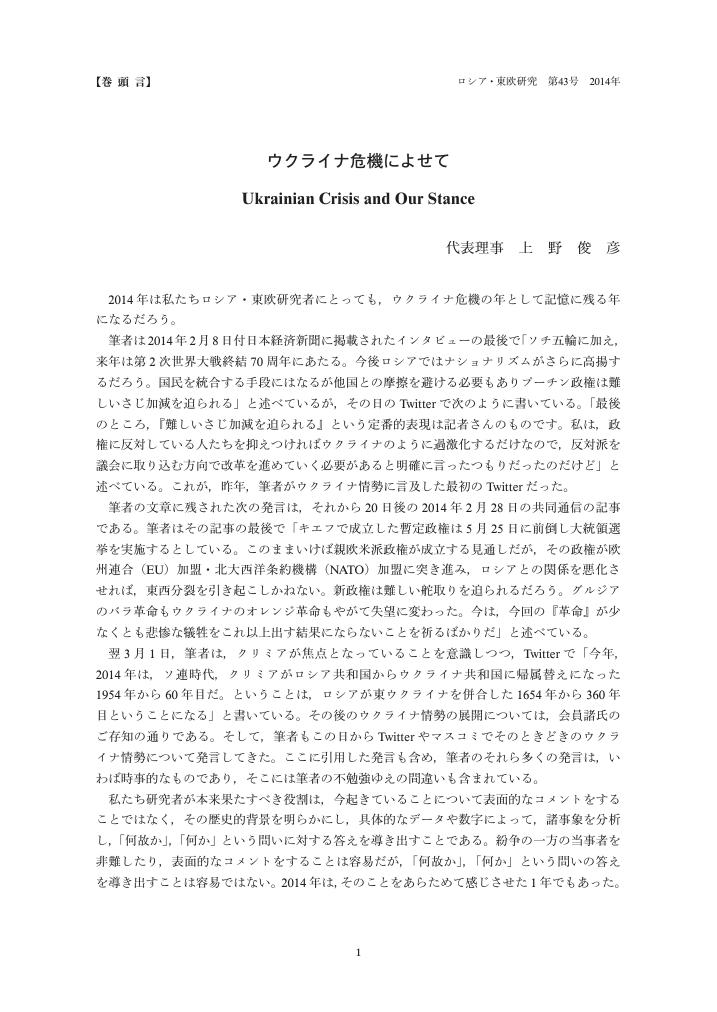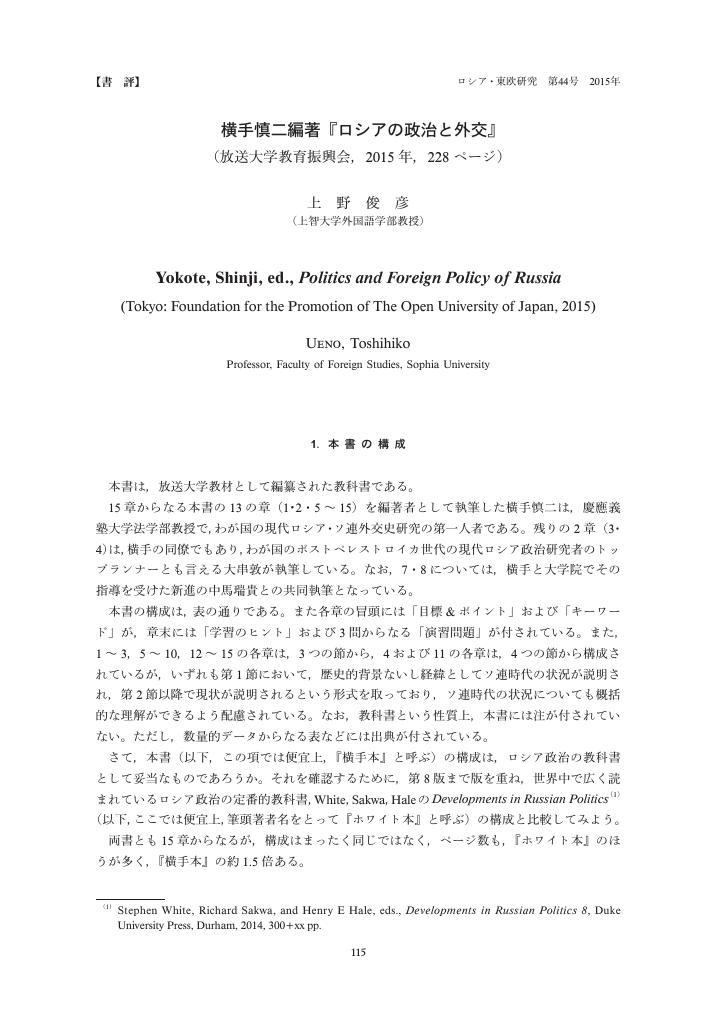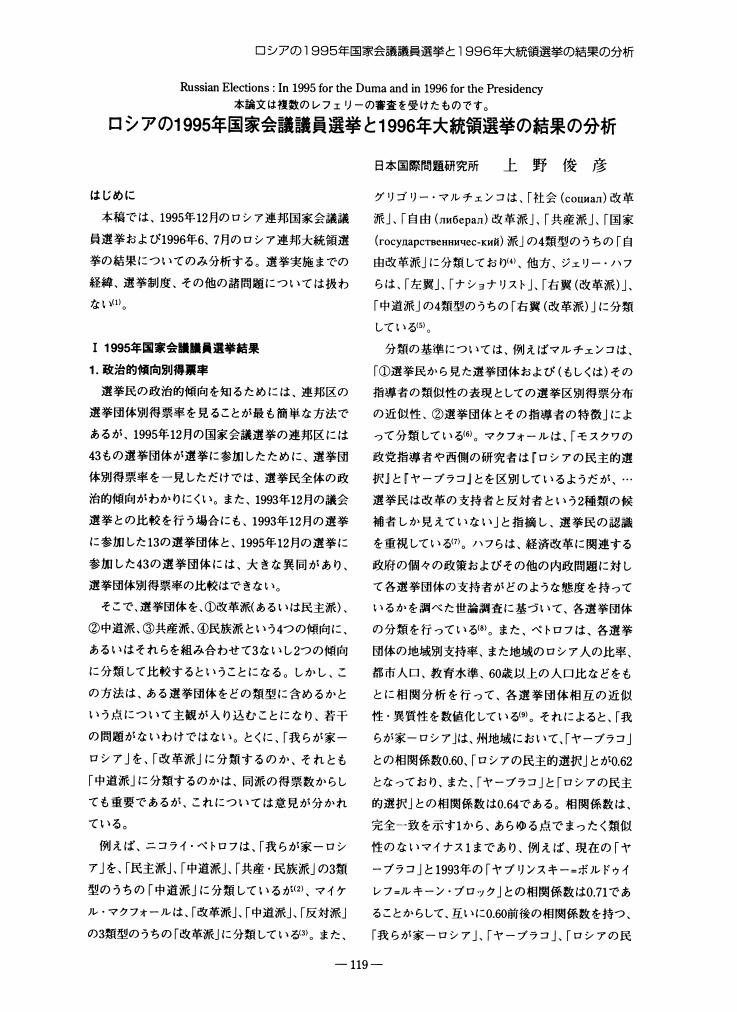4 0 0 0 OA ロシア連邦の下院選挙制度
- 著者
- 上野 俊彦
- 出版者
- 日本選挙学会
- 雑誌
- 選挙研究 (ISSN:09123512)
- 巻号頁・発行日
- vol.31, no.1, pp.56-70, 2015 (Released:2018-03-23)
現行ロシア連邦憲法下の下院選挙制度の変化の概要について,発足時から現在に至るまで,選挙法の改正を中心に解説する。ロシア連邦の下院の選挙制度は,小選挙区比例代表並立制から純粋比例代表制へと代わり,次の2016年12月に予定されている選挙から再び小選挙区比例代表制に戻ることになっている。
4 0 0 0 IR ソ連邦共産党第28回大会をめぐる諸問題
- 著者
- 上野 俊彦
- 出版者
- 慶應義塾大学法学研究会
- 雑誌
- 法学研究 (ISSN:03890538)
- 巻号頁・発行日
- vol.68, no.2, pp.p329-357, 1995-02
太田俊太郎教授退職記念号はじめに第一章 ソ連邦共産党第二八回大会繰り上げ開催決定までの経緯第二章 大会代議員選出手続きと代議員の社会的構成第三章 ロシア共和国共産党創立大会第四章 綱領的宣言第五章 党規約おわりに
3 0 0 0 OA プーチン政権とロシア国内情勢
- 著者
- 上野 俊彦
- 出版者
- ロシア・東欧学会
- 雑誌
- ロシア・東欧学会年報 (ISSN:21854645)
- 巻号頁・発行日
- vol.2000, no.29, pp.1-11, 2000 (Released:2010-05-31)
- 参考文献数
- 52
The author analyzes President Putin's career in the first chapter of this paper. The analysis shows that President Putin has two different backgrounds. One of them - that he was with the Soviet intelligence organ, KGB - is well known. The other is that he used to be part of the economic bureaucracy of St. Petersburg. These two disparate backgrounds are a sign ficant part of Putin's identity. Indeed, most of the executives in the President's office, as well as the Cabinet members andplenipotentiary representatives of federative regionsthat President Putin appointed, have careers similar to Putin's. This is a defining characteristic of the Putin administration.Furthermore, the author points out that one of the important features of Putin's political style is that he manipulates political, national and traditional symbols or images. One example is that at the time of the presidential election he emphasized his image of“a powerful leader”along the lines of Peter the Great, Alexander I, Stalin, and so on. Even after his inauguration as President this manipulation of symbols has continued. For example, he has enacted laws concerning the national flag, the national anthem and the national crest, which are legacies not only of the tradition of Imperial Russia but also of the Soviet Union. With such symbols, President Putin evokes nationalistic and patriotic enthusiasm among people and he has succeeded in mobilizing the support of the people.In the second chapter of the paper, President Putin's regional policy based on a revival of“a powerful state”is discussed. His regional policy is, in short, the strengthening of centralization or the vertical administrative system within the federal state. He demands that local legislation conform to the federal constitution and laws. Moreover, he has changed the procedures for forming the Upper House and has begun to weaken the authority of the Upper House. He has also tried to reduce the governors' authority. Moreover, plenipotentiary representatives of federative regionshave been sent out in order to strengthen central control over regions. President Putin is seeking to build a“strong Russia”through these regional policies.
2 0 0 0 OA ウクライナ危機によせて
- 著者
- 上野 俊彦
- 出版者
- ロシア・東欧学会
- 雑誌
- ロシア・東欧研究 (ISSN:13486497)
- 巻号頁・発行日
- vol.2014, no.43, pp.1, 2014 (Released:2016-09-09)
- 被引用文献数
- 1
1 0 0 0 OA 横手慎二編著『ロシアの政治と外交』 (放送大学教育振興会,2015年,228ページ)
- 著者
- 上野 俊彦
- 出版者
- ロシア・東欧学会
- 雑誌
- ロシア・東欧研究 (ISSN:13486497)
- 巻号頁・発行日
- vol.2015, no.44, pp.115-119, 2015 (Released:2017-08-18)
1 0 0 0 OA 書評 皆川修吾著『ロシア連邦議会―制度化の検証: 1994~2001―』
1 0 0 0 OA エリツィン「過渡期」政権の政治システム ―ロシア政治研究の新しい視覚の模索―
- 著者
- 上野 俊彦
- 出版者
- ロシア・東欧学会
- 雑誌
- ソ連・東欧学会年報 (ISSN:03867226)
- 巻号頁・発行日
- vol.1992, no.21, pp.15-24, 1992 (Released:2010-05-31)
1 0 0 0 OA ソ連邦共産党第19回全連邦協議会以降の党の制度改革と指導部人事
- 著者
- 上野 俊彦
- 出版者
- ロシア・東欧学会
- 雑誌
- ソ連・東欧学会年報 (ISSN:03867226)
- 巻号頁・発行日
- vol.1989, no.18, pp.1-8, 1989 (Released:2010-05-31)
- 参考文献数
- 40
1 0 0 0 OA 現代ソ連における党およびソヴェート制改革に関する若干の諸問題
- 著者
- 上野 俊彦
- 出版者
- THE JAPANESE ASSOCIATION FOR RUSSIAN AND EAST EUROPEAN STUDIES
- 雑誌
- ソ連・東欧学会年報 (ISSN:03867226)
- 巻号頁・発行日
- vol.1987, no.16, pp.84-94, 1987 (Released:2010-03-16)
- 参考文献数
- 22
1 0 0 0 OA ソ連における「国家管理理論」と行政改革
- 著者
- 上野 俊彦
- 出版者
- THE JAPANESE ASSOCIATION FOR RUSSIAN AND EAST EUROPEAN STUDIES
- 雑誌
- ソ連・東欧学会年報 (ISSN:03867226)
- 巻号頁・発行日
- vol.1985, no.14, pp.127-136, 1985 (Released:2010-03-16)
- 参考文献数
- 24
1 0 0 0 OA ソ連における 「発達した社会主義社会の政治システム」 論成立とその内容
- 著者
- 上野 俊彦
- 出版者
- THE JAPANESE ASSOCIATION FOR RUSSIAN AND EAST EUROPEAN STUDIES
- 雑誌
- ソ連・東欧学会年報 (ISSN:03867226)
- 巻号頁・発行日
- vol.1983, no.12, pp.62-73, 1983 (Released:2010-03-16)
- 参考文献数
- 29
1 0 0 0 OA ソ連における政治研究の現状
- 著者
- 上野 俊彦
- 出版者
- THE JAPANESE ASSOCIATION FOR RUSSIAN AND EAST EUROPEAN STUDIES
- 雑誌
- ソ連・東欧学会年報 (ISSN:03867226)
- 巻号頁・発行日
- vol.1982, no.11, pp.100-111, 1982 (Released:2010-03-16)
- 参考文献数
- 19
1 0 0 0 OA ロシアの1995年国家会議議員選挙と1996年大統領選挙の結果の分析
- 著者
- 上野 俊彦
- 出版者
- ロシア・東欧学会
- 雑誌
- ロシア・東欧学会年報 (ISSN:21854645)
- 巻号頁・発行日
- vol.1996, no.25, pp.119-141, 1996 (Released:2010-05-31)
- 参考文献数
- 15
1 0 0 0 OA インターネット特別分科会
- 著者
- 上野 俊彦
- 出版者
- ロシア・東欧学会
- 雑誌
- ロシア・東欧学会年報 (ISSN:21854645)
- 巻号頁・発行日
- vol.1996, no.25, pp.161-168, 1996 (Released:2010-05-31)
1 0 0 0 ロシアの議会選挙と大統領選挙を視察して (特集 近くて遠い国)
- 著者
- 上野 俊彦
- 出版者
- 上智大学
- 雑誌
- ソフィア (ISSN:04896432)
- 巻号頁・発行日
- vol.57, no.3, pp.277-317, 2008
1 0 0 0 東西南北 クリミア半島、歴史の旅
- 著者
- 上野 俊彦
- 出版者
- 渋沢栄一記念財団
- 雑誌
- 青淵 (ISSN:09123210)
- 巻号頁・発行日
- no.785, pp.16-18, 2014-08










